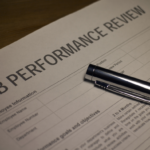
by admin | May 25, 2021 | Human Resources
 The right performance management process for your organization depends in large part on what you want to accomplish with it and what you’re willing to invest in it. Here are some principles to keep in mind when deciding on your policy and performing assessments:
The right performance management process for your organization depends in large part on what you want to accomplish with it and what you’re willing to invest in it. Here are some principles to keep in mind when deciding on your policy and performing assessments:
- Performance reviews are often stressful and difficult because the employees don’t know how they’ll be evaluated and they’re worried they’ll be surprised with a bad review. But reviews, however often they’re done, shouldn’t be a surprise. If you give employees regular feedback on their performance and address poor performance when it happens, then the review becomes more of a reminder and summary of what employees are doing well and where they have opportunities to improve.
- Setting clear performance expectations and holding employees accountable to them improves efficiency and productivity. It also improves morale. Conversations with an underperforming employee may be challenging, but allowing poor performance to continue unabated can cause widespread frustration and resentment from coworkers whose work is affected by it. Ignoring poor performance only compounds the problem.
- Employees are more likely to take ownership over their performance goals if they have a role in defining those goals.
- Connecting performance measures to company objectives and values can increase employees’ sense of purpose and engagement by drawing a direct correlation between their individual work and performance and your collective success as a company.
- It’s helpful to structure performance evaluation meetings and conversations around the specific expectations set in the job description to ensure that the discussion is directly applicable to that employee’s particular job duties.
- Documenting performance evaluations can help you justify pay increases, decreases, or other employment decisions like termination that could be challenged as discriminatory. It’s safest to terminate an employee when you have documentation that justifies the legitimate business reasons for the termination.

by admin | May 4, 2021 | Benefit Management, Human Resources
 The overall well-being of an employee has never been more of a priority for employers as it is right now. From health care to vision care to mental health care, the entirety of the employee’s health is important to the health of the organization.
The overall well-being of an employee has never been more of a priority for employers as it is right now. From health care to vision care to mental health care, the entirety of the employee’s health is important to the health of the organization.
Importance of Mental Health Benefits
Mental health and the cost of not treating its issues has far-reaching effects from the individual to the global world.
- If left untreated, an employee’s poor mental health could lead to work related accidents, absenteeism, poor workplace productivity, and even workplace violence.
- Mental health costs make up about 8% of the US’s total healthcare spending.
- The National Institute on Mental Health estimates that major mental illness costs the US at least $193 billion per year in lost earnings.
- Globally, depression and anxiety issues cost about $1 trillion a year.
Types of Mental Health Benefits
Mental health benefits can look different for each organization. Universally, businesses offer some sort of Employee Assistance Program (EAP) to its members. EAPs include services that are typically delivered online or by telephone. Services may include alcohol and substance abuse counseling, legal aid, and health and wellness counseling. These services are offered to the employee free of charge and are done anonymously.
As an extension of basic health care benefits, mental health benefits can also include one-on-one counseling with a licensed counselor for a certain number of sessions. Mental health benefits may also incorporate wellness programs like relaxation and meditation classes, sleep techniques, and stress management lessons. Check your health insurance benefits package details as you may find mental health insurance coverage included under the behavioral health section.
During open enrollment, when employers present the employees with the upcoming year’s health insurance plans, the employee should also ask about mental healthcare options. Just as you assess the different healthcare plans and what fits best for you and your family, you can also assess the costs and coverage of mental health plans. Also, find out if your company offers a Flexible Spending Account as you can use that pre-tax money to pay for out-of-pocket mental health service costs.
Now, more than ever, people are more aware of the benefits to good mental health and how it affects their overall health and work performance. Utilize the company sponsored EAP offerings and investigate the details of your health insurance plan to find out what mental health services are covered. Your overall health and well-being are important and so are you!

by admin | Apr 27, 2021 | Human Resources
 Remote Onboarding Success Plan
Remote Onboarding Success Plan
Remote workplaces have become very commonplace in our world today. In fact, a PwC survey of 669 CEOs, 78% agree that remote work is here for the long-term. As a result, remote onboarding has become part of the normal Human Resources operation in companies. Let’s dive into what remote onboarding looks like and some benefits and challenges of this new way of welcoming employees to the team.
What is onboarding?
Onboarding is the process of welcoming new employees to the company and introducing them to the company culture of their new employer. Onboarding is different from training in that training focuses on the policies and procedures of the job while onboarding is more focused on integrating the new hire to the team and helping them develop relationships within the workplace. Remote onboarding has the same focus but everything is done online through Zoom or other virtual meeting platforms. Onboarding is also not a one-time event. It’s a process that takes multiple days and an ongoing commitment to truly acclimate the new employee to the department.
Challenges of remote onboarding
Connecting virtually with others can have its challenges. Coordinating the entire team’s schedule to welcome new hires as they arrive on the team can be hard. This same challenge happens as the team attempts to continue to build camaraderie with some in-person team members and other remote team members. As many of us have come to understand, working remotely can be very isolating. Throw in joining a new team, and your new hire can feel extremely unengaged. Another challenge is technology set up in a remote environment. When onboarding in person, the IT department can physically be there to issue company technology. Remote onboarding relies on the new employee setting up their own technology or walking through set-up with an IT representative online.
Tips for remote onboarding success
Despite the challenges, remote onboarding can be a successful experience. Here are some tips to overcome some of these obstacles and make your new hire feel engaged and part of the team by the end of their remote onboarding process.
- Set up a kick-off video call with your entire team to welcome the new member. By having a video call, you make it easier for names and faces to connect. Video welcome calls also allow the new hire to see the enthusiasm in the faces of their new team and begin to build an emotional connection.
- Provide an organizational chart so that the remote employee understands the reporting lines in the company. Additionally, consider including pictures of those included on the chart so they can put faces to names. Another great way to go to the next level to connect with the new hire would be to pre-record quick welcome videos by the high-level execs and send them via email.
- Introduce the new employee to the company via email or social media. Do a simple “Getting to Know You” interview with them so you can share some interesting facts about this new team member.
- Regularly check-in via quick chat messages or video call with your remote new hire to find out if they have any questions or concerns in their first week(s). By having scheduled times where you connect with your new employee, they will have less of a chance to feel alone and will begin to learn your management style.
According to ServiceNow, “enthusiasm for a job peaks at the start of the job and wanes by 22% shortly thereafter.” Now is the time to capture your new hire’s enthusiasm and encourage its growth. While remote onboarding can be a challenge, it is possible to overcome the obstacles it presents with some careful planning and dedication to its success.

by admin | Apr 22, 2021 | Human Resources, Workplace
 Think for a minute about all you have done today. Now, from that list of tasks, how many would you say you have done well? Again, from the list of tasks you feel you’ve done a good job on, how many were you praised for by your manager or even a co-worker? We all crave approval and praise from others in our life. The workplace is no exception. Praise motivates us to do well and to improve. Praise is necessary and praise is powerful. Follow these easy steps to build an effective habit of praise in your organization.
Think for a minute about all you have done today. Now, from that list of tasks, how many would you say you have done well? Again, from the list of tasks you feel you’ve done a good job on, how many were you praised for by your manager or even a co-worker? We all crave approval and praise from others in our life. The workplace is no exception. Praise motivates us to do well and to improve. Praise is necessary and praise is powerful. Follow these easy steps to build an effective habit of praise in your organization.
The WHY of Praise
Before we can get into the HOW of praise, let’s touch on the WHY. According to Gallup.com, “Recognition for good work releases dopamine in the brain, which creates feelings of pride and pleasure.” People want to feel like others see them and appreciate them. The praise-giver also receives benefits from this exchange. By giving praise, you get the same sense of satisfaction as you get when making a charitable gift or helping others. An environment of praise-giving is one where individuals work, not just to complete a task and be done, but they work to do a good job and to please their manager with hard work that is done well. Also, in terms of employee engagement, a manager who regularly praises their team, is one who is
The HOW of Praise
Giving praise is easy and, if you follow these simple tips, it is also an effective tool to motivate and encourage those in your workplace.
Make it QUICK
When you notice something that should be recognized with praise, do it immediately. The more time that passes between the event and the recognition, the less powerful the praise becomes. Make it a habit that when you see good work or good behavior, you stop what you are doing and give praise.
Make it SPECIFIC
Now that you have recognized the behavior or project that deserves praise, you’ll want to make the praise specific. Offering a vague compliment like, “You did good” doesn’t truly speak to the specific action that is praise-worthy. Instead, make your words of affirmation ones that point to a specific instance like, “The logo you created for the Milestone marketing project was clean and really inventive.”
Make it GENUINE
You may be tempted to adopt this new praise policy and start doling out compliments left and right like a praise shotgun, but, don’t. Disingenuous praise is almost as bad, if not worse, than no praise at all. You can tell if someone is making a forced comment or one that has no thought behind it. Instead, make sure the praise is given with a genuine heart and tone.
Create a CULTURE of praise
As you fine tune the act of giving praise in your workplace, your final task is to create a culture of praise-giving. When you build this culture, and everyone is actively involved in recognizing their peers, you will find the morale and engagement in your office is lifted higher. Increased morale and engagement also increase productivity, lowers absenteeism, and lowers turnover.
Praise is incredibly powerful. Praise has the power to motivate, encourage, and build. By following the simple tips outlined here, you can unleash the power of praise in your organization and in your life and reap the benefits to both the giver and receiver.

by ckistler | Mar 30, 2021 | Benefit Management, Human Resources

Just as with any good, healthy relationship, communication with employees is key. Only communicating with employees regarding their benefits package during open enrollment will most definitely result in them not taking full advantage of all it has to offer. In an effort to assist employees in understanding and maximizing their benefits, companies should use a year-round benefits engagement strategy. Let’s explore some simple ways to set up your annual communication plan.
START WITH THE END IN MIND
As you begin crafting your engagement plan, think of the overall goal you want to accomplish. Perhaps you simply want your employees to be better educated on their plan offerings. Maybe you’d like to reduce the number of questions that employees ask during open enrollment meetings. Or, maybe you want your employees to utilize a certain plan benefit that has been historically underused resulting in higher costs to the employee or the company. Whatever the case, first set your goal for the communication plan.
CREATE A CALENDAR
Now that you have an end-goal in mind, start thinking of how frequently you want to communicate. Schedule your communication moments to post consistently. Maybe you start a “Benefits Minute” that hits the first Monday of the month. Or, start a “Benefits Blog” that posts every other Friday. Whatever the case, make the communication happen on a schedule so that employees know when to expect it and know what it’s called.
KEEP IT SIMPLE
Wordy emails, drawn-out meetings, and forever long phone messages will quickly get ignored and deleted. Instead, follow this simple formula when crafting your communication:
- Here’s what you need to know about your benefits.
Give a quick overview of the benefit you are focusing on for this particular communication.
- Here’s why it’s important that you know this.
In a few short sentences, explain how this benefit benefits the employee whether it be a cost savings, time savings, or simply a great help to them.
3. Here’s what you need to do to find out more.
Provide a way to find out more information on this benefit by giving a link, an email address, or a phone number.
MIX UP YOUR COMMUNICATION STYLE
Communication isn’t one-size-fits-all. People learn in different ways—some may be visual learners while others may be oral learners. Make sure you mix up the way you communicate to cover both types. Also, change up the method of communication. Try emails, explainer videos, printed flyers, and quick, stand-up meetings. By using a variety of methods, you are able to engage a broader audience since your company is comprised of a range of ages, genders, learners, and tech users.
Engaging in a regular, year-round communication strategy for explaining employee benefits will support both the company as well as the employee. Set your strategy in motion by following the simple tips shared here. And, when you do this, you will see that your employees will reap the benefits of a healthy understanding of their benefit plan.

by ckistler | Mar 23, 2021 | Human Resources, Workplace
 There has been so much written on leadership in the last year, it’s hard to keep track of it all. Leaders should be storytellers, communicators, holistic, strategic, encouraging, creative, conservative, risk taking, ethical, competitive, inspiring and a whole host of other attributes.
There has been so much written on leadership in the last year, it’s hard to keep track of it all. Leaders should be storytellers, communicators, holistic, strategic, encouraging, creative, conservative, risk taking, ethical, competitive, inspiring and a whole host of other attributes.
There are countless books currently available on the subject, and it would not surprise me if there were close to over half a million articles on the subject. It is the bread and butter of every consulting firm throughout the world. With so much content offering thought and insight, you have to wonder why leadership still an issue?
The answer lies with culture. The entire purpose of leadership is to create a culture. In a large and well-established organization, it can be difficult for an outsider to implement a new culture. So, does leadership create a culture or does culture create leadership? The answer to both questions is yes.
Culture Affecting Leadership
“I have been here 25 years,” said the director of a large municipality. “I have outlasted three city managers so far, and I will outlast this one.” This is the attitude many leaders face, especially when they are brought in from outside organizations to run or manage large, well-established ones.
The negative cultures can especially undermine positive leadership as initiatives are actively undermined by managers who have a stake in the old culture or struggle to accept the changes inherent in the modern workplace. Whether it’s through manipulation or complacency, negative cultures can create significant challenges for change. At the same time, positive leadership can overcome negative culture and turn the tide over time. A few encouraging results and positive experiences can go a long way.
Negative leadership, however, can have a fast, dramatic effect on a positive culture. WorldCom was a telecom leader and had a very innovative culture until Bernie Ebbers took over. While squeezing every cent he could from the environment and putting pressure on employees to work harder with less, he was pillaging the company. Turnover soared and, within a few years, WorldCom was bankrupt.
Culture as a Function of Leadership
Companies reflect the ethics of the leaders who run them. We’ve seen in recent times the reaction employees and the public have to companies who fail to address their stance on social issues, harassment, pay gaps and whose political leanings go against what employees view to be the common good.
As a result, leaders find themselves having to publicly make statements condemning systemic racism, political violence and other topics that aren’t easy to talk about without offending someone or putting oneself at risk. But ultimately, the ethical stands a leader takes becomes a part of the organization’s culture.
Bob Page felt like an outsider and had to hide his sexuality. When he built Replacements, Ltd., he ensured everyone it would be a place that accepted diversity—not just of lifestyle but of thought—and would invest in building their community. Anita Roddick founded The Body Shop to build an environmentally-friendly corporation, which reflected her commitment to environmental activism. Jim Goodnight’s commitment to work-life balance is part of the culture at SAS, the largest privately-held company in the world. Jack Welch’s commitment to being the best created an environment of excellence at General Electric. In each of these cases, the ethics of the leader became a central part of the culture.
The Obstacles to Culture Change
The real obstacles to culture change are internal obstacles. False ego, fear, complacency and preconceived ideas create a negative environment. When change is introduced there is resistance, even when the change is positive. People learn different coping mechanisms to avoid the change, such as hiding behind procedures, “water cooler” talk or actively undermining the initiative.
The remote work landscape changes some of this as employee communications can be more easily monitored and there are fewer “water cooler” moments on offer to begin with. But negativity can me a bit like trying to contain water in an enclosed space. If there’s a place for it to leak through, it likely will. The question then becomes how leadership can have a positive impact on the culture of an organization?
Ways Leadership Can Positively Affect Culture
People are inspired by vision. They want to follow a leader who shows concerns and values that are important to them. A positive leader will inspire 100% effort from everybody. Here are some signs of a good leader and how the leader affects the culture:
- Visionaries and strategic thinkers: A boss tells you what to do, while a leader inspires you to want to do it. Leaders who lay out a vision that people buy into and a strategy that they understand will create a culture of engagement. People know where the organization is headed, how it will get there and their role in helping achieve the vision.
- Ethics that support values: People look at what you do and not what you say. Values are words, ethics are actions. When leaders demonstrate values through their actions, they lead by example and create an ethical culture.
- Empowerment: There are three requirements for: responsibility, accountability and authority. Leaders who empower people to make decisions that affect their lives, give them the authority to act and make them take responsibility for consequences create leadership on all levels of the organization. Micromanaging means people are not entrusted to be leaders and very little gets done because all decisions need to be made by one person.
By David Whiting
Originally posted on hrexchangenetwork.com.
 The right performance management process for your organization depends in large part on what you want to accomplish with it and what you’re willing to invest in it. Here are some principles to keep in mind when deciding on your policy and performing assessments:
The right performance management process for your organization depends in large part on what you want to accomplish with it and what you’re willing to invest in it. Here are some principles to keep in mind when deciding on your policy and performing assessments:




